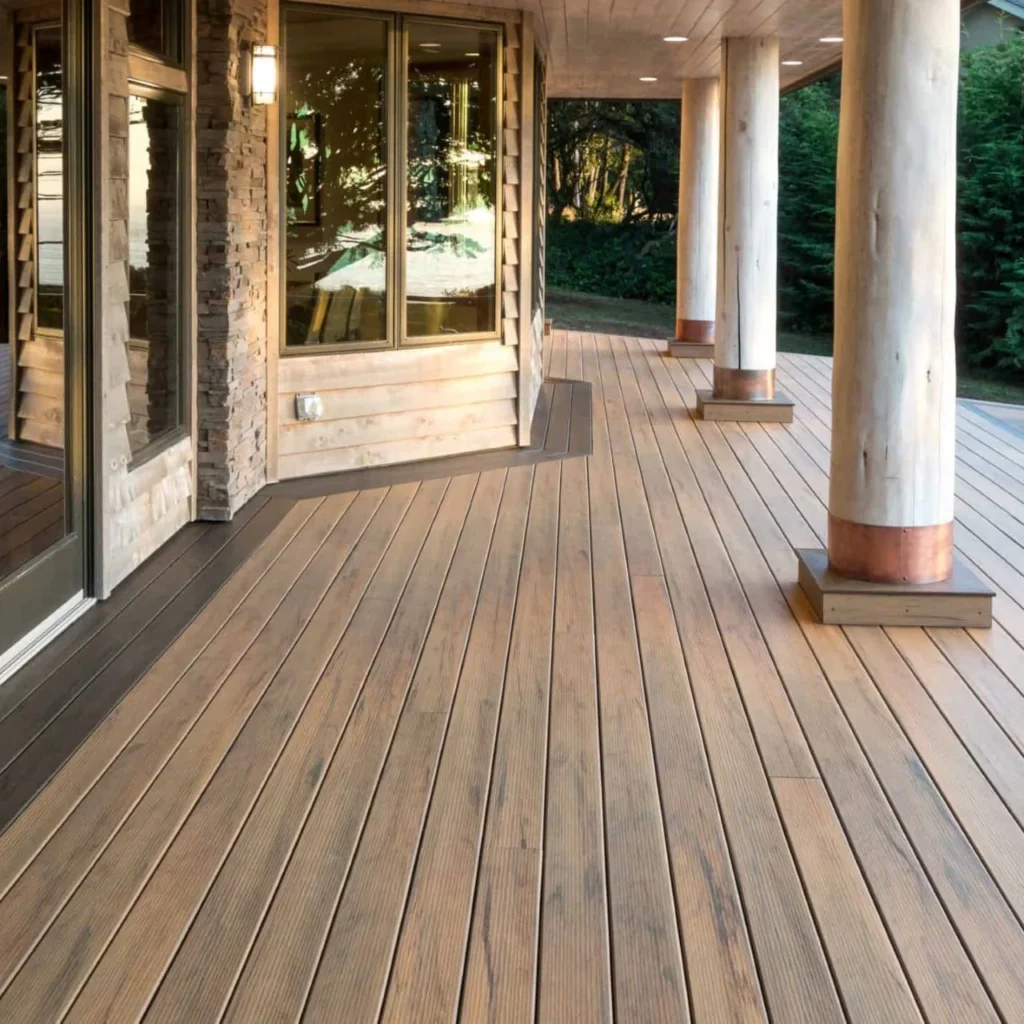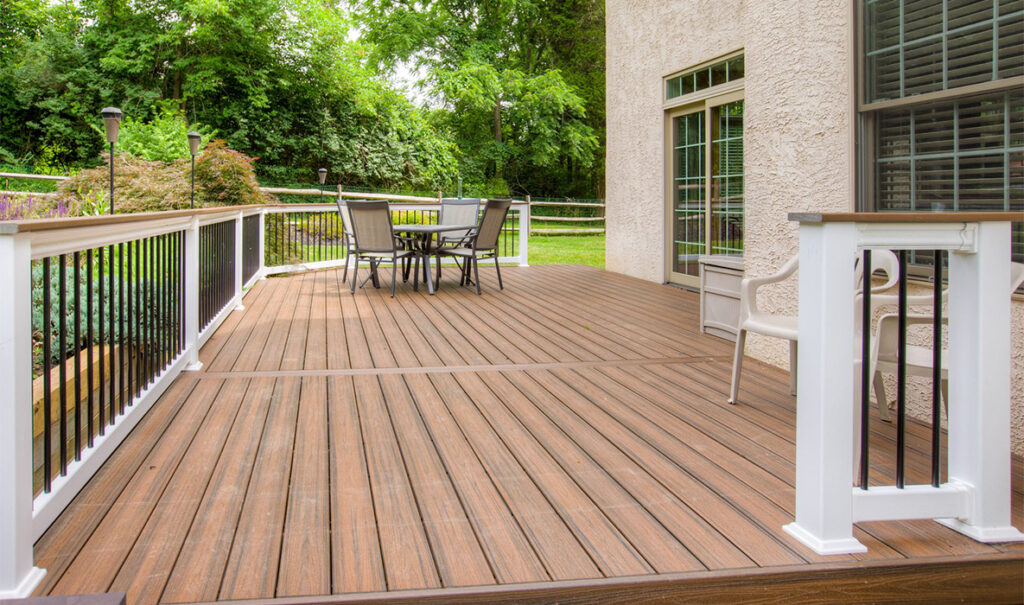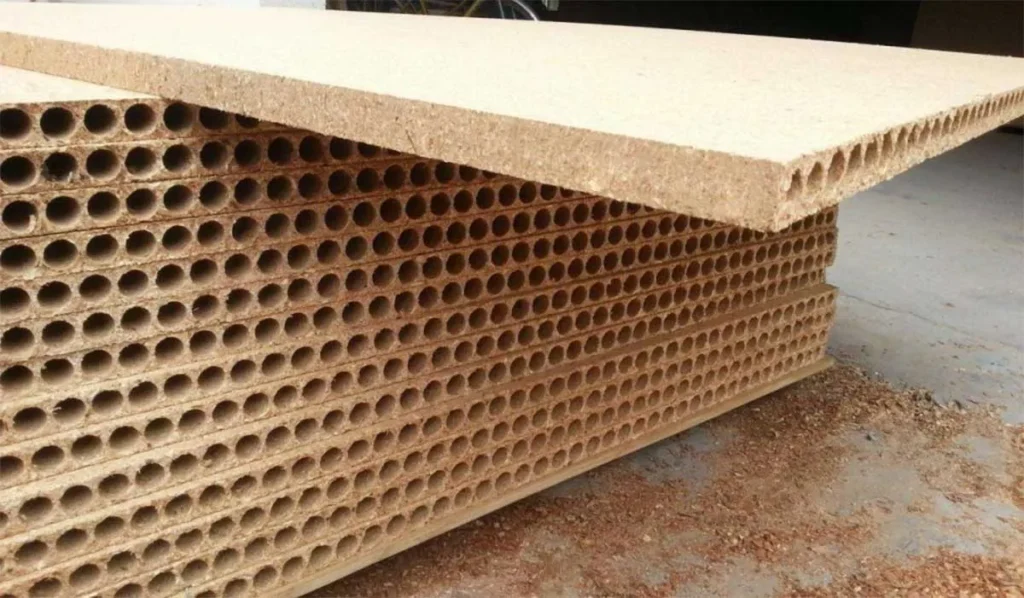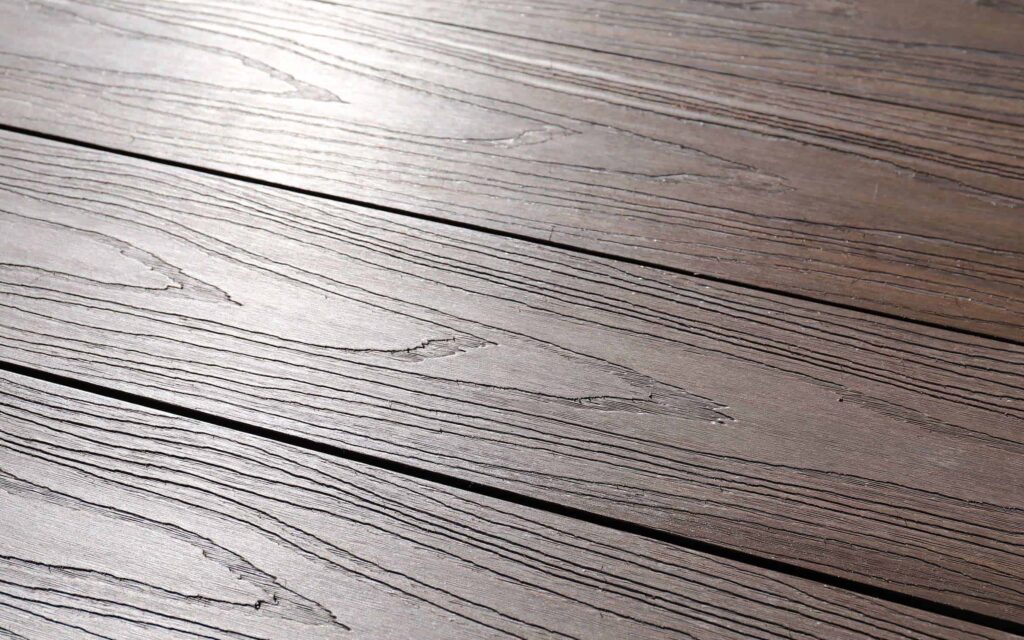Composite Decking Uganda
Composite Decking Uganda
Overview
At Fern Flooring Experts Uganda, we build composite decking that looks smart, drains well, and close to maintenance-free flooring that’s designed perfectly for the real Ugandan weather.
Composite boards is made of wood fibers and polymers to form a stable, waterproof plank that resists rot, splinters, and termites. As opposed to the normal wood tiles, composite decking is maintenance-free and much durable.
You get a clean outdoor floor for balconies, verandas, pool decks, and rooftop terraces that stays neat with simple washing. Tukwaniriza to outdoor living that feels easy every day.
Our Uganda composite decking flooring solution begin on site. Our team measures, checks structure, and maps sun and rain paths. You review full-length boards, colors, and textures in your own light. We explain profiles, clips, substructure options, and edge trims in plain language, then agree on a layout that fits your sawa and views.
You see where steps land, how water leaves, and how furniture zones line up before we fix a single screw.
Composite decking is appropriate for busy homes and hospitality spaces that receives a lot of visitors and you cant spend the whole day cleaning. Boards do not warp like untreated timber, and hidden clips leave no raised screws to catch bare feet.
To maintain composite decking floor, you just need a simple periodic wash with mild soap that restores the finish after dust or a storm. Mpola mpola, your deck becomes the favorite place for breakfast, family time, or sunset service without eating your weekend on maintenance.

Composite Decking Uganda Benefits
Designed for rainy season
Uganda’s showers can be sudden. Composite boards do not swell or rot, and the color holds under strong sun. Grooved surfaces improve traction, while proper spacing and slope move water away. You host guests in Entebbe humidity or Fort Portal mist without worrying about soft boards or peeling paint. Webale nnyo for choosing calm over constant repairs.
Low, predictable Maintenance cost
Composite decking eliminates sanding, staining, and annual sealing cycles. You sweep grit, rinse, and occasionally use a neutral cleaner. Hospitality teams finish closing duties faster. Homeowners reclaim weekends once spent on oiling planks. Over the years, the lower maintenance cost balances the higher initial spend and protects your time.
Gain splinter-free comfort for kids and pets
Hidden fixings that look refined, termite resistance without harsh chemicals, and color choices that pair with stone, render, or brick. The deck stays stable, so furniture sits level and doors glide cleanly.
Durable
Quality boards last 25 to 30 years with consistent appearance. Capped composites resist rot, termites, and warping. You keep the deck structure stable through harsh sun and heavy rain.
Different types of Composite Decking Uganda



Capped composite boards for maximum stain resistance.
A protective outer layer shields the core from spills and UV. Cafés and pool decks love the easy wipe-down after busy hours. Capped boards keep color sharp and resist oil and wine marks better than uncapped options. Choose this when service speed matters or when barbecue season never sleeps.
Solid composite boards for heavy loads.
Where you expect planters, gym equipment, or frequent furniture moves, solid profiles carry weight and mute footfall. You feel a firm step and hear less drum. These boards suit hotels, schools, and large family verandas that host events. The tradeoff is a slightly higher material cost that repays you with long service.
Hollow core boards for lighter structures.
Hollow profiles reduce weight and cost while still resisting water and insects. On upper floors and long balconies, the lighter load helps engineering and budget. Correct end caps and trims keep the look finished and prevent debris from entering the cavities. Use where traffic is moderate and furniture is light.
Slip-resistant textured boards for wet zones.
Around pools, outdoor showers, and lakefront jetties, a deeper texture adds confidence under wet feet. These surfaces clean with a soft brush and neutral detergent. You balance grip with cleanability so staff can restore the deck quickly after service or a swim.
Composite Decking Uganda Installation Procedure
Survey and design. We measure, check structure, map drainage, and agree layout and borders.
Substructure preparation. We install treated timber or metal joists, set heights, and confirm slope.
Board placement. We dry-lay patterns, fix hidden clips, and align joints for clean sight lines.
Edge and detail work. We add trims, steps, access hatches, and movement breaks where needed.
Clean and handover. We wash down, inspect, and share a simple care plan. Tukwaniriza.
Where to Apply Composite Decking Uganda
Home verandas and balconies.
Create a morning coffee corner or evening family spot with boards that never splinter under bare feet. Neutral greys or warm browns pair with plants and stone planters. Add a subtle border plank to frame outdoor furniture and keep the layout crisp.
Hotels, lodges, and cafés.
Guests carry sand, sunscreen, and drinks. Capped composite boards shrug off stains and rinse clean between sittings. We integrate access hatches for service points and design expansion breaks that hide within pattern lines. The result is a tidy deck that stays photo ready.
School terraces and community spaces.
Students need safe footing and easy care. Composite decks reduce splinters and handle constant movement. Color bands or inlays guide flow without extra signs. Maintenance teams sweep and rinse mpola mpola, then move on to the next task with time to spare.
Pool surrounds, jetties, and rooftop terraces.
Drainage and grip matter most here. We set slope toward discreet channels, specify deeper textures, and select trims that block wind uplift on rooftops. The surface stays comfortable on hot afternoons and avoids the glare you often see on tiles.
Common Asked Questions
You’re probably wondering…
There are so many self proclaimed tile, granite & other flooring experts. Why Fern Flooring?
Because every agency operates under different constraints:
team quality, location, approach, and cost of labor.
So let’s cut through the noise and show you exactly where we stand.
Top 8 Uganda composite decking flooring FAQs
Will composite decking fade or stain in Uganda’s sun and rain?
Capped boards resist UV better and hold color longer than uncapped styles. All boards experience a light initial tone shift, then stabilize. Routine rinsing removes red soil and city dust that can dull the look. For food and oil spills, a quick wipe within minutes prevents marks. Staff can carry a small kit with neutral cleaner and cloths to standardize response during busy service.
If stains occur, most lift with soap, water, and a soft brush. Avoid harsh abrasives that scratch the cap. Where trees drop sap, schedule a weekly rinse in rainy months. A little consistency keeps the finish bright without adding labor. Over seasons, you see a steady, even tone rather than patchy wear.
How slippery is composite when wet, especially near pools?
Textured profiles and clear drainage design control risk. We specify deeper textures around wet zones and set the deck to slope gently so water leaves and algae struggles to settle. Routine sweeping removes fine grit that can turn any surface slick. In hospitality, mats at pool entries and quick wipe-downs during service help keep traction reliable.
If you love a smoother finish for dining areas, we place textured bands in narrow lanes near doors and taps. These targeted strips guide movement and add security without changing the overall look. Safety lives in small decisions that do not burden cleaning teams or guests.
What substructure should I use and will wood joists rot?
Substructure choice follows location, height, and loads. Treated timber joists work well off the ground with good airflow and isolation pads. Steel or aluminum frames suit rooftops, coastal zones, and heavy commercial sites. We separate joists from standing water, design for expansion, and use stainless fixings in critical areas.
Rot appears when trapped moisture has no escape. We keep air gaps, block soil contact, and protect cut ends. Regular visual checks after the first rainy season catch any issues early. With smart detailing, the frame stays sound while boards remain stable and quiet underfoot.
Can composite decking handle Uganda’s heat without warping?
Composite expands with temperature, so correct spacing and clips matter. We leave manufacturer-specified gaps, choose lighter colors for sun-exposed rooftops, and break long runs with hidden expansion details. This prevents buckling and keeps lines straight through hot afternoons and cool nights. Doors, rails, and drain covers align cleanly because the plan respects movement.
In shaded verandas, expansion is milder, but the same principles apply. A deck that looks perfect on day one and stays neat in month twelve starts with spacing and slope. Kale, design first, then speed.
How do I clean and maintain day to day?
Start with grit control. Sweep leaves and dust, then rinse with a hose. Use a neutral cleaner for sticky spots. Avoid oil-based polishes that attract dirt. For cafes and lodges, a weekly routine with a soft brush brings back texture and removes any film. Keep nearby gutters clear so soil does not wash onto the deck during storms.
If mold appears in shaded corners, a gentle cleaner formulated for composites lifts it without bleaching the color. Always test in a hidden spot first. With these habits, your deck stays presentable with less effort than timber or porous tile. Before you know it, the routine becomes second nature.
Can I place heavy furniture, planters, or a hot tub on composite decking?
Yes, within structural limits. The deck’s capacity depends on joist spacing, board choice, and frame material. For concentrated loads like spas or large planters, we reinforce joists and add pads to spread weight. Furniture with smooth feet prevents point damage. We share a simple load diagram during design so you know exactly where heavy items should sit.
Rolling grills or trolleys work if wheels are wide and clean. Avoid dragging sharp legs across boards. When in doubt, lift or use sliders. These small habits keep the surface even and protect edges for the long term.
How long does installation take and can we keep trading?
Balconies and small verandas finish quickly once the frame is ready. Large lodges and school terraces phase by zones so life continues safely. Noisy cutting happens at sensible hours, and we keep safe paths open. You receive a day-by-day plan that shows survey, framing, decking, and clean-up. Staff and family plan around clear milestones, not guesswork.
Return to use often follows immediately after installation because there is no wet paint or sealer to cure. We still request a short pause before moving heavy furniture so clips settle and trims set. Clear signs and a friendly briefing keep everyone aligned.
What budget should I expect and how do I control costs?
Costs include boards, clips, substructure, trims, and labor. Capped and solid profiles cost more but deliver longer service and faster cleaning. Hollow cores save weight and money in low-load areas. Metal frames cost more upfront yet shine on rooftops and coastal sites where longevity matters. After survey, we present options side by side with lifecycle notes.
Control costs with good design. Keep board lengths efficient, avoid tiny offcuts, and choose one border detail across zones. Plan hose bibs and power points before we start to prevent late changes. A tidy plan saves days on site and protects your budget.
Conclusion
Composite decking gives you a stable, splinter-free outdoor floor that ignores rain, resists termites, and cleans fast. You choose color, texture, and structure. We design for drainage and movement, build a strong frame, fix boards with hidden clips, and hand over a care plan you can follow without stress. The result is an outdoor space you will use every day, not a chore list.
Ready to see full-length samples, confirm layout, and price options clearly. Request a Quote from Fern Flooring Experts. We will schedule a site visit, measure, verify structure, and present a fair proposal that respects your timeline.